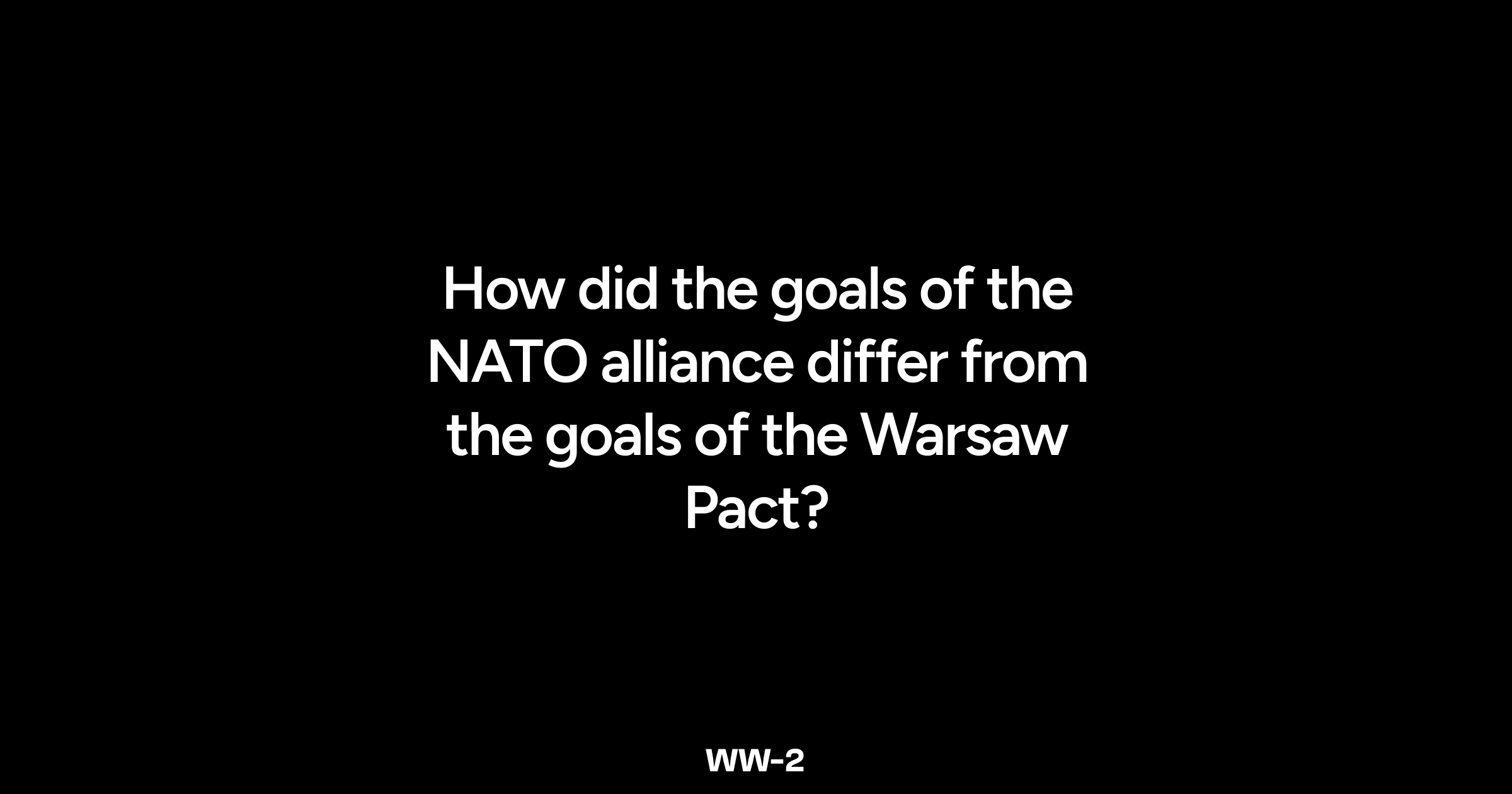The North Atlantic Treaty Organization (NATO) and the Warsaw Pact were two military alliances formed during the Cold War. NATO was founded in 1949 by the United States, Canada, and several Western European nations to provide collective security against the Soviet Union. The Warsaw Pact was founded in 1955 by the Soviet Union and seven other Soviet satellite states in Central and Eastern Europe to counter NATO.
The main goals of NATO were to:
- deter aggression against its members
- protect the freedom and security of its members
- promote democratic values and institutions
- prevent conflict
- build trust and cooperation among its members
The main goals of the Warsaw Pact were to:
- deter aggression against its members
- protect the socialist system in its member states
- promote cooperation among its members
- prevent war
What is NATO?
The North Atlantic Treaty Organization (NATO) is an intergovernmental military alliance of 30 member states based in Europe and North America. Established in the aftermath of World War II, the organization implements the North Atlantic Treaty, signed in Washington, D.C., on April 4, 1949. NATO is a collective security system: its independent member states agree to defend each other against attacks by third parties.
The main goals of NATO are to:
- deter aggression against its members
- protect the freedom and security of its members
- promote democratic values and institutions
- prevent conflict
- build trust and cooperation among its members
NATO has been involved in a number of military operations, including the 1999 bombing of Yugoslavia, the 2001 invasion of Afghanistan, and the 2011 intervention in Libya. The alliance is currently engaged in a number of training and capacity-building missions in the Middle East and North Africa.
NATO is headquartered in Brussels, Belgium. The current Secretary General of NATO is Jens Stoltenberg.
The member states of NATO are:
- Albania
- Belgium
- Bulgaria
- Canada
- Croatia
- Czech Republic
- Denmark
- Estonia
- Finland
- France
- Germany
- Greece
- Hungary
- Iceland
- Italy
- Latvia
- Lithuania
- Luxembourg
- Montenegro
- Netherlands
- North Macedonia
- Norway
- Poland
- Portugal
- Romania
- Slovakia
- Slovenia
- Spain
- Turkey
- United Kingdom
- United States
NATO is a major force for peace and stability in Europe. It has helped to deter aggression, protect its members, and promote democratic values. The alliance is committed to maintaining peace and security in the Euro-Atlantic region, and it will continue to play an important role in the years to come.
What is Warsaw Pact?
The Warsaw Pact, formally the Treaty of Friendship, Cooperation and Mutual Assistance (TFCMA), was a collective defense treaty signed in Warsaw, Poland, between the Soviet Union and seven other Eastern Bloc socialist republics of Central and Eastern Europe in May 1955, during the Cold War.
The main goals of the Warsaw Pact were to:
- deter aggression against its members
- protect the socialist system in its member states
- promote cooperation among its members
- prevent war
The Warsaw Pact was dominated by the Soviet Union, and its decisions were ultimately made by the Soviet government. The pact also had a military arm, the Warsaw Treaty Organization (WTO), which was responsible for the defense of its members.
The Warsaw Pact was dissolved on July 1, 1991, after the fall of the Soviet Union. The dissolution of the Warsaw Pact marked the end of the Cold War and the beginning of a new era of cooperation and integration in Europe.
The member states of the Warsaw Pact were:
- Albania (withdrawn in 1968)
- Bulgaria
- Czechoslovakia
- East Germany
- Hungary
- Poland
- Romania
- Soviet Union
The Warsaw Pact was a major factor in the Cold War. It helped to deter aggression from the West and to maintain the Soviet Union’s influence in Eastern Europe. The pact also played a role in the suppression of dissent in Eastern Europe.
After the fall of the Soviet Union, the Warsaw Pact was dissolved. However, its legacy continues to be felt in Europe. The former member states of the Warsaw Pact are now all members of NATO, and they are working to build a new security architecture for Europe.
How did the goals of the nato alliance differ from the goals of the Warsaw pact?
Although the goals of NATO and the Warsaw Pact were similar, there were some key differences.
- NATO was a defensive alliance, while the Warsaw Pact was a more offensive alliance.
- NATO was also more democratic, while the Warsaw Pact was more authoritarian.
- Another key difference was that NATO was based on the principle of collective security, while the Warsaw Pact was based on the principle of individual security.
Under the principle of collective security, all NATO members were obligated to come to the aid of any member that was attacked. Under the principle of individual security, each Warsaw Pact member was responsible for its own defense.
Ultimately, the goals of NATO and the Warsaw Pact were to prevent war and maintain peace in Europe. However, the two alliances also played a role in the Cold War, which was a period of tension and rivalry between the United States and the Soviet Union.
After the fall of the Soviet Union in 1991, the Warsaw Pact dissolved. NATO has since expanded to include many former Warsaw Pact countries, and it remains a major force for peace and stability in Europe.
